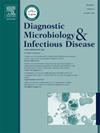Diaper-based diagnostics: A novel non-invasive method for urine collection and molecular testing of uropathogens
IF 2.1
4区 医学
Q3 INFECTIOUS DISEASES
Diagnostic microbiology and infectious disease
Pub Date : 2025-06-06
DOI:10.1016/j.diagmicrobio.2025.116939
引用次数: 0
Abstract
Urinary tract infections (UTIs) present a global diagnostic challenge, especially in populations where midstream urine collection is impractical. This study evaluates sodium polyacrylate-based diapers as a non-invasive matrix for urine collection, coupled with quantitative PCR (qPCR) for uropathogen detection. Phase I involved 17 samples (7 contrived, 10 from diaper-wearing volunteers), and Phase II analyzed 35 de-identified clinical specimens using a CLIA/CAP-validated qPCR panel targeting 17 bacteria, 4 fungi, 6 antimicrobial resistance genes, and 1 control gene. Diaper-derived samples demonstrated 100 % concordance in positive and negative predictive values with standard urine specimens. Across all clinical samples, mean cycle threshold (Ct) differences ranged from –2.06 to 3.87 (mean absolute difference = 1.43), with lower variability in diaper samples (SD = 4.02 vs. 4.48) and strong correlation in Ct values (r = 0.97). These findings validate the diaper matrix as a clinically robust, non-invasive alternative that maintains diagnostic integrity under simulated transport and storage. This approach enables accurate molecular detection of uropathogens while minimizing invasive procedures, offering immediate applicability for infants, the elderly, and individuals with incontinence—thereby enhancing diagnostic access, accuracy, and antimicrobial stewardship in vulnerable populations.
基于尿布的诊断:一种新的非侵入性尿液收集和尿路病原体分子检测方法
尿路感染(uti)提出了一个全球性的诊断挑战,特别是在人群中游尿液收集是不切实际的。本研究评估了聚丙烯酸钠纸尿裤作为尿液收集的无创基质,并结合定量PCR (qPCR)检测尿路病原体。第一阶段涉及17个样本(7个人为样本,10个来自穿着尿布的志愿者),第二阶段使用CLIA/ cap验证的qPCR面板分析了35个去鉴定的临床样本,针对17种细菌,4种真菌,6种抗菌素耐药基因和1个对照基因。纸尿裤衍生样本在阳性和阴性预测值与标准尿液样本100%一致。在所有临床样本中,平均周期阈值(Ct)差异范围为-2.06至3.87(平均绝对差异= 1.43),尿布样本的变异性较低(SD = 4.02 vs. 4.48), Ct值的相关性较强(r = 0.97)。这些发现验证了纸尿裤基质作为一种临床可靠的、非侵入性的替代方法,在模拟运输和储存下保持诊断的完整性。这种方法能够准确地检测尿路病原体,同时最大限度地减少侵入性手术,为婴儿、老年人和失禁患者提供即时适用性,从而提高易感人群的诊断可及性、准确性和抗菌药物管理。
本文章由计算机程序翻译,如有差异,请以英文原文为准。
求助全文
约1分钟内获得全文
求助全文
来源期刊
CiteScore
5.30
自引率
3.40%
发文量
149
审稿时长
56 days
期刊介绍:
Diagnostic Microbiology and Infectious Disease keeps you informed of the latest developments in clinical microbiology and the diagnosis and treatment of infectious diseases. Packed with rigorously peer-reviewed articles and studies in bacteriology, immunology, immunoserology, infectious diseases, mycology, parasitology, and virology, the journal examines new procedures, unusual cases, controversial issues, and important new literature. Diagnostic Microbiology and Infectious Disease distinguished independent editorial board, consisting of experts from many medical specialties, ensures you extensive and authoritative coverage.

 求助内容:
求助内容: 应助结果提醒方式:
应助结果提醒方式:


